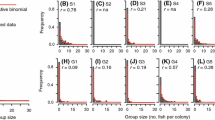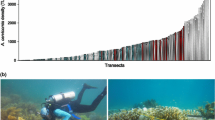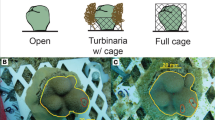Abstract
Stony corals are the foundation species of tropical reefs, and their structures can harbor a diverse range of mutualist taxa that can confer important benefits, including provision of nutrients. Prominent among the associates of branching coral in the genus Pocillopora are groups of zooplanktivorous damselfishes that take refuge in the coral to avoid their predators. In field and laboratory experiments, we explored the effects of colonies of resident damselfishes on growth of their host corals. Laboratory studies revealed a positive relationship between biomass of fish and output of ammonium. In the field, levels of ammonium were significantly elevated in the water surrounding the branches of Pocillopora occupied by colonies of damselfish, particularly in time periods following active feeding by the fish. Experimental manipulation of the presence of fish on host corals during a month-long field experiment revealed that corals hosting fish grew significantly more than those that lacked fish, and coral growth was positively correlated with the biomass of resident fish. The Pocillopora colonies in the field experiment varied in the degree of openness of their branching structure, and dye studies indicated that this affected their ability to retain waterborne nutrients. Together with biomass of resident fish, colony openness explained 76% of the variation in coral growth rate during the experiment. Corals can exhibit considerable morphological variability, and mutualistic fish respond to colony architecture during habitat selection, with some species preferring more open-branched forms. This makes it likely that corals may face tradeoffs in attracting resident fish and in retaining the nutrients they provide.







Similar content being viewed by others
References
Abele LG, Patton WK (1976) The size of coral heads and the community biology of associated decapod crustaceans. J Biogeogr 3:35–47. doi:10.2307/3038097
Bray RN, Purcell LJ, Miller C (1986) Ammonium excretion in a temperate-reef community by a planktivorous fish, Chromis punctipinnis (Pomacentridae), and potential uptake by young giant kelp, Macrocystis pyrifera (Laminariales). Mar Biol (Berl) 90:327–334. doi:10.1007/BF00428556
Bray RN, Miller AC, Johnson S, Krause PR, Robertson DL, Westcott AM (1988) Ammonium excretion by macroinvertebrates and fishes on a subtidal rocky reef in southern California. Mar Biol (Berl) 100:21–30. doi:10.1007/BF00392951
Brooks AJ, Holbrook SJ, Schmitt RJ (2007) Patterns of microhabitat use by fishes in the patch-forming coral Porites rus. Raffles Bull Zool S14:245–254
Davies PS (1989) Short-term growth measurements of corals using an accurate buoyant weighing technique. Mar Biol (Berl) 101:389–395. doi:10.1007/BF00428135
Done TJ, Dayton PK, Dayton AE, Steger R (2001) Regional and local variability in recovery of shallow coral communities: Moorea, French Polynesia and central Great Barrier Reef. Coral Reefs 9:183–192. doi:10.1007/BF00290420
Falkowski PG, Dubinsky Z, Muscatine L, McCloskey L (1993) Population control in symbiotic corals: ammonium ions and organic materials maintain the density of zooxanthellae. Bioscience 43:606–611. doi:10.2307/1312147
Fautin D (1991) The anemonefish symbiosis: what is known and what is not. Symbiosis 10:23–46
Fautin D, Allen GR (1997) Anemone fishes and their host sea anemones. Western Australian Museum, Perth, 160 p
Godwin J, Fautin DG (1992) Defense of host actinians by anemonefishes. Copeia 1992:902–908. doi:10.2307/1446171
Goldshmid R, Holzman R, Weihs D, Genin A (2004) Aeration of corals by sleep-swimming fish. Limnol Oceanogr 49:1832–1839
Grover R, Maguer J-F, Reynaud-Vaganay S, Ferrier-Pagès C (2002) Uptake of ammonium by the scleractinian coral Stylophora pistillata: effect of feeding, light, and ammonium concentrations. Limnol Oceanogr 47:782–790
Helmuth BST, Sebens KP, Daniel TL (1997) Morphological variation in coral aggregations: branch spacing and mass flux to coral tissues. J Exp Mar Biol Ecol 209:233–259. doi:10.1016/S0022-0981(96)02687-1
Holbrook SJ, Schmitt RJ (2002) Competition for shelter space causes density-dependent predation mortality in damselfishes. Ecology 83:2855–2868
Holbrook SJ, Schmitt RJ (2003) Spatial and temporal variation in mortality of newly settled damselfish: patterns, causes and co-variation with settlement. Oecologia 135:532–541
Holbrook SJ, Schmitt RJ (2004) Population dynamics of a damselfish: effects of a competitor that also is an indirect mutualist. Ecology 85:979–985. doi:10.1890/03-0406
Holbrook SJ, Schmitt RJ (2005) Growth, reproduction and survival of a tropical sea anemone (Actiniaria): benefits of hosting anemonefish. Coral Reefs 24:67–73. doi:10.1007/s00338-004-0432-8
Kaandorp JA (1999) Morphological analysis of growth forms of branching marine sessile organisms along environmental gradients. Mar Biol (Berl) 134:295–306. doi:10.1007/s002270050547
Kane C, Brooks AJ, Holbrook SJ, Schmitt RJ (2008) The role of microhabitat preference and social organization in determining the spatial distribution of a coral reef fish. Environ Biol Fishes (in press)
Lassig BR (1977) Communication and coexistence in a coral community. Mar Biol (Berl) 42:85–92. doi:10.1007/BF00392016
Liberman T, Genin A, Loya Y (1995) Effects on growth and reproduction of the coral Stylophora pistillata by the mutualistic damselfish Dascyllus marginatus. Mar Biol (Berl) 121:741–746. doi:10.1007/BF00349310
Lowe RJ, Koseff JR, Monismith SG, Falter JL (2005) Oscillatory flow through submerged canopies: 2. Canopy mass transfer. J Geophys Res 110:C10017. doi:10.1029/2004JC002789
Meyer JL, Schultz ET (1985a) Migrating haemulid fishes as a source of nutrients and organic matter on coral reefs. Limnol Oceanogr 30:146–156
Meyer JL, Schultz ET (1985b) Tissue condition and growth rate of coral associated with schooling fish. Limnol Oceanogr 30:157–166
Mokady O, Loya Y, Lazar B (1998) Ammonium contribution from boring bivalves to their coral host - a mutualistic symbiosis? Mar Ecol Prog Ser 169:295–301. doi:10.3354/meps169295
Munday PL (2004) Habitat loss, resource specialization, and extinction on coral reefs. Glob Change Biol 10:1642–1647. doi:10.1111/j.1365-2486.2004.00839.x
Muscatine L, Porter JW (1977) Reef corals mutualistic symbioses adapted to nutrient-poor environments. Bioscience 27:454–460. doi:10.2307/1297526
Muscatine L, Masuda H, Burnap R (1979) Ammonium uptake by symbiotic and aposymbiotic reef corals. Bull Mar Sci 29:572–575
Patton WK (1994) Distribution and ecology of animals associated with branching corals (Acropora spp.) from the Great Barrier Reef, Australia. Bull Mar Sci 55:193–211
Pinnegar JK, Polunin NVC (2006) Planktivorous damselfish support significant nitrogen and phosphorus fluxes to Mediterranean reefs. Mar Biol (Berl) 148:1089–1099. doi:10.1007/s00227-005-0141-z
Porat D, Chadwick-Furman NE (2004) Effects of anemonefish on giant sea anemones: expansion behavior, growth, and survival. Hydrobiologia 530/531:513–520. doi:10.1007/s10750-004-2688-y
Porat D, Chadwick-Furman NE (2005) Effects of anemonefish on giant sea anemones: Ammonium uptake, zooxanthellae content and tissue regeneration. Mar Freshwat Behav Physiol 38:43–51. doi:10.1080/10236240500057929
Pratchett MS (2001) Influence of coral symbionts on feeding preferences of crown-of-thorns starfish Acanthaster planci in the western Pacific. Mar Ecol Prog Ser 214:111–119. doi:10.3354/meps214111
Pratchett MS, Vytopil E, Parks P (2000) Coral crabs influence the feeding patterns of crown-of-thorns starfish. Coral Reefs 19:36. doi:10.1007/s003380050223
Reidenbach MA, Koseff JR, Monismith SG, Steinbuck JV, Genin A (2006) The effects of waves and morphology on mass transfer within branched reef corals. Limnol Oceanogr 51:1134–1141
Roopin M, Henry RP, Chadwick NE (2008) Nutrient transfer in a marine mutualism: patterns of ammonia excretion by anemonefish and uptake by giant sea anemones. Mar Biol (Berl) 154:547–556. doi:10.1007/s00227-008-0948-5
SAS Institute (2003) SAS version 9.1. SAS Institute, Cary
Schmitt RJ, Holbrook SJ (1999) Settlement and recruitment of three damselfish species: larval delivery and competition for shelter space. Oecologia 118:76–86. doi:10.1007/s004420050705
Schmitt RJ, Holbrook SJ (2000) Habitat-limited recruitment of coral reef damselfish. Ecology 81:3479–3494
Schmitt RJ, Holbrook SJ (2007) The scale and cause of spatial heterogeneity in the strength of temporal density dependence. Ecology 88:1241–1249. doi:10.1890/06-0970
Spotte S (1996) Supply of regenerated nitrogen to sea anemones by their symbiotic shrimp. J Exp Mar Biol Ecol 198:27–36. doi:10.1016/0022-0981(95)00169-7
Stewart HL, Holbrook SJ, Schmitt RJ, Brooks AJ (2006) Symbiotic crabs maintain coral health by clearing sediments. Coral Reefs 25:609–615. doi:10.1007/s00338-006-0132-7
Thompson AR, Nisbet RM, Schmitt RJ (2006) Dynamics of mutualist populations that are demographically open. J Anim Ecol 75:1239–1251. doi:10.1111/j.1365-2656.2006.01145.x
Vytopil E, Willis BL (2001) Epifaunal community structure in Acropora spp. (Scleractinia) on the Great Barrier Reef: implications of coral morphology and habitat complexity. Coral Reefs 20:281–288. doi:10.1007/s003380100172
Acknowledgments
We thank Sarah Gravem, Keith Seydel, Stephen Holloway and Beth O’Connor for their assistance with this work. This research was supported by grant OCE 04-17412 from the National Science Foundation and gifts from the Gordon and Betty Moore Foundation and the W. M. Keck Foundation. This is a contribution of the Moorea Coral Reef (MCR) LTER Site and is Contribution No. 146 from the U.C. Berkeley Gump Research Station. All experiments described in this paper were conducted in accordance with current laws of French Polynesia and the United States governing the use of animals in research.
Author information
Authors and Affiliations
Corresponding author
Additional information
Communicated by S.D. Connell.
Rights and permissions
About this article
Cite this article
Holbrook, S.J., Brooks, A.J., Schmitt, R.J. et al. Effects of sheltering fish on growth of their host corals. Mar Biol 155, 521–530 (2008). https://doi.org/10.1007/s00227-008-1051-7
Received:
Accepted:
Published:
Issue Date:
DOI: https://doi.org/10.1007/s00227-008-1051-7




